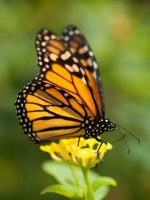In this article you’ll get to know some of the most fascinating monarch butterfly facts for kids. The monarch butterfly (Danaus plexippus) is the most familiar butterfly in North America. It is a milkweed butterfly. Monarch butterflies are also called common tiger, black-veined brown, milkweed, and wanderer. They are often confused with viceroy butterfly for both shares the same patterns on their wings.
Monarch Butterfly🦋Facts for Kids
There are three living species of monarch butterflies. These are D. plexippus, D. erippus, and D. cleophile.
Adult monarchs have a wingspan measuring at 8.9 to 10.2 cm. They are mainly recognized by their tawny orange uppersides together with black margins. There are white spots on black margins.
The monarch caterpillar is 25 to 45 mm long and 5 to 8 mm in width.
Monarch Migration: Monarch butterflies are highly migratory species. They will fly at a speed of 5.5 miles per hour. The average human jogs at 6 – 8 mph.
Although both male and female appear to be of same length males are slightly bigger in size.
 Monarchs have six legs but they do not use all six legs. They will use rear legs and middle legs while the forelegs are held against its body.
Monarchs have six legs but they do not use all six legs. They will use rear legs and middle legs while the forelegs are held against its body.
Monarch Butterfly Diet: They will feed on many different nectar plants. Monarch butterfly’s diet includes wild carrot, teasel, goldenrod, blazing stars, milkweeds, coneflowers, thistles, asters, horseweed, and red clover. Monarch larvae are thought to feed only on milkweed.
Monarch butterflies breed throughout the North America including northern South America and southern Canada. They are also found in Caribbean Islands, New Caledonia, Bermuda, Hawaii, Cook Islands, New Zealand, Australia, Gibraltar, North Africa, Canary Islands, Papua New Guinea, and Solomon Islands.
The overwintering monarchs live in Mexico, Florida, Arizona, and Virginia.
Monarch Butterfly Habitat: Monarchs make homes in a variety of habitats such as pasture lands, gardens, suburban residential areas, roadsides, trees, prairie remnants, mulberries, oaks, willows, elms, and cottonwoods.
Female monarchs lay creamy colored to greenish eggs that are conical in shape. The size of the monarch’s eggs is 1.2×0.9 mm and weighs up to 0.5 mg. The female lays as many as 290 – 1190 eggs. The size of the egg depends on the size of the female; the larger is the female the bigger is the egg.
The eastern population of monarchs migrates 4,830 miles (7,778 km) to Mexico in winter.
Females usually lay eggs on milkweeds. Eggs take 3 – 8 days to develop into larva or a caterpillar.
Predators of monarch butterfly are grackles, sparrows, pinyon jays, thrashers, robins, black-headed grosbeak, orioles, and scrub jays.
Monarch Lifespan: Adult monarchs have a lifespan of about 14 to 35 days.





